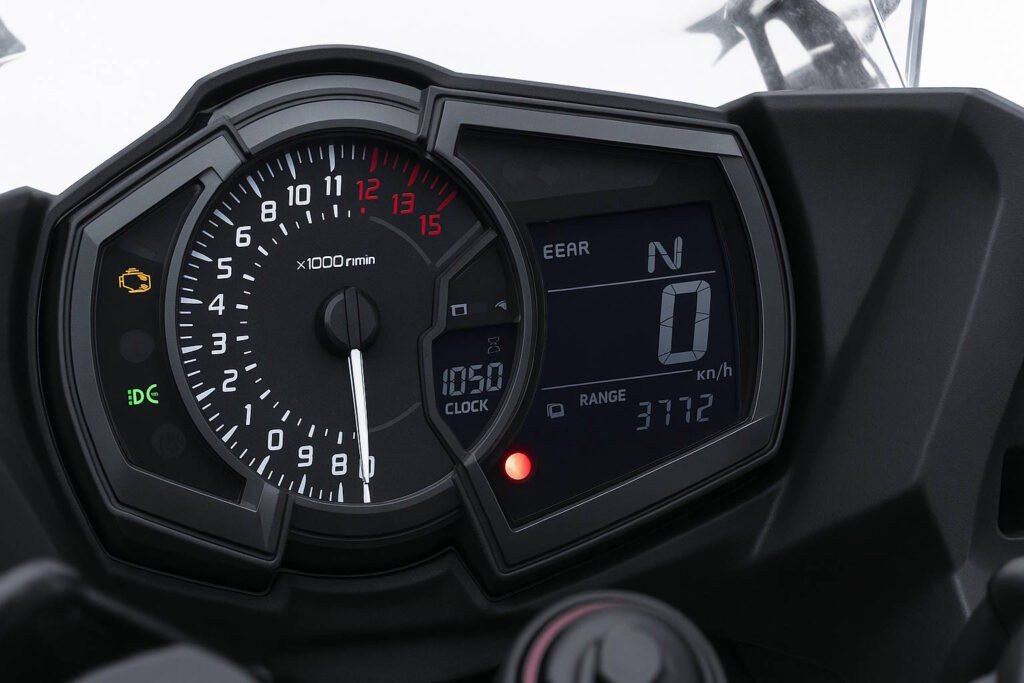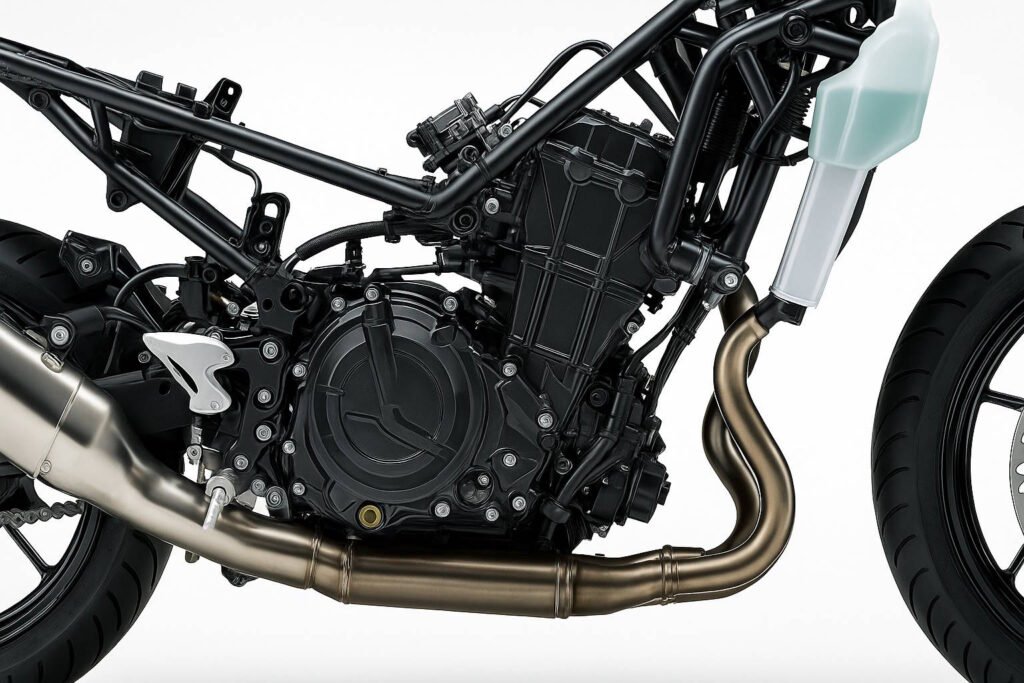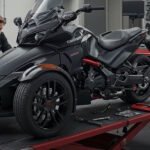The Kawasaki Ninja 400 has earned its reputation as a top choice for riders seeking an entry-level sportbike that doesn’t compromise on performance. Combining user-friendly handling with impressive speed, it appeals to both newcomers and seasoned enthusiasts. But just how fast can this lightweight machine go?
In this comprehensive guide, we’ll explore the Kawasaki Ninja 400’s top speed, real-world performance, and what riders can expect when pushing the limits.
The Official Top Speed

This motorcycle has an official top speed of approximately 119 mph (192 km/h) under optimal conditions. This maximum speed makes it one of the fastest motorcycles in the entry-level sport bike segment. Powered by a:
- 🏍️ Engine: 399cc parallel-twin engine
- ⚡ Horsepower: 49 HP @ 10,000 RPM for thrilling acceleration
- 💥 Torque: 38 Nm @ 8,000 RPM for strong mid-range pull
It typically accelerates from 0 to 100 km/h (0 to 62 mph) in approximately 4.6 to 5.0 seconds under ideal conditions. For the 0 to 100 mph (0 to 161 km/h) time, which is less commonly cited, the Ninja 400 takes roughly 15-16 seconds.
That Ninja motorcycle delivers impressive straight-line performance despite its modest displacement.
Power Delivery and RPM Performance
-
Low RPM (2,000–4,000): Smooth and Manageable
At lower RPMs, the Ninja 400 offers smooth and manageable power delivery, making it ideal for city commuting and stop-and-go traffic. Riders have noted that the engine pulls well even at low RPMs, providing a forgiving and user-friendly experience in urban settings.
-
Mid-Range RPM (5,000–8,000): Responsive and Engaging
In the mid-range, the engine becomes more responsive, offering punchy acceleration suitable for highway passing and spirited riding. This range provides a balance between performance and control, allowing riders to enjoy dynamic riding without overwhelming power.
-
High RPM (Above 8,000): Sporty and Exciting
Beyond 8,000 RPM, Engine continues to deliver power up to its redline, giving experienced riders the exhilarating feel of a sportbike. While it doesn’t match the extreme performance of larger supersport motorcycles, it provides a thrilling experience without the intimidation factor.
Fuel Efficiency and Capacity
Riders can expect approximately 56–61 mpg (Miles Per Gallon) in city conditions and 61–70 mpg on highway rides, depending on riding habits and conditions. With a 3.7-gallon (14-liter) fuel tank, the Ninja 400 offers a substantial range, allowing for extended rides without frequent refueling.
Estimated Range: This translates to a theoretical range of approximately 210–240 miles between fill-ups, making it suitable for both daily commuting and longer journeys. The Ninja 400 runs efficiently on regular 87 octane gasoline, eliminating the need for premium fuel and offering cost savings over time.
Cooling System and Engine Longevity

The Ninja 400 features a liquid-cooling system that helps maintain optimal operating temperatures even in hot weather or stop-and-go traffic. This cooling efficiency contributes to the impressive expected engine lifespan.
With proper maintenance, many owners report their Ninja 400 engines easily surpassing 50,000 miles without major issues. Some have even pushed beyond 80,000 miles while maintaining good performance. The key is following the recommended maintenance schedule and not abusing the engine with constant redlining or improper break-in.
Physical Dimensions and Ergonomics
The Ninja 400 has a wet weight of 366 pounds (with ABS), making it one of the lighter sport bikes on the market. This translates to easy handling for riders of all experience levels.
The seat height is 30.9 inches, which accommodates most riders without feeling too cramped or stretched. The overall dimensions are approximately 78.3 inches in length, 28.3 inches in width, and 45.7 inches in height.
Ground clearance sits at 5.5 inches, providing sufficient room for normal riding conditions while maintaining a sporty profile.
Passenger Capability
Yes, the Ninja 400 can carry a passenger! The bike comes with a dedicated passenger seat, rear footpegs, and grab handles, making two-up riding completely viable. However, like most sport bikes, comfort for longer trips may be limited for the passenger.
ABS vs Non-ABS
The primary difference between ABS and non-ABS models is the anti-lock braking system, which prevents wheel lock-up during hard braking. The ABS model typically costs $400 more than the non-ABS version.
The ABS system adds about 4-5 pounds to the bike’s weight—a negligible difference for most riders. There are no other performance differences between the models.
For safety reasons, the ABS option is highly recommended, especially for newer riders or those who frequently ride in varying weather conditions.
Factors That Impact Your Top Speed
While 119 mph looks impressive on paper, several factors determine whether you’ll actually reach this speed on your Ninja 400:
1. Rider Weight and Position
Physics doesn’t lie: a lighter rider will typically achieve higher top speeds than a heavier one. Additionally, your riding position dramatically affects aerodynamics:
- Tucked position: Reduces drag significantly, potentially adding 5-10 mph to your top speed
- Upright position: Creates more wind resistance, reducing potential top speed
A 150-pound rider in a full racing tuck will likely achieve higher speeds than a 220-pound rider sitting upright.
2. Environmental Conditions
The environment plays a crucial role in determining your actual top speed:
- Headwinds: Can reduce top speed by 5-15 mph depending on intensity
- Tailwinds: May add a few mph to your top speed
- Altitude: Higher elevations mean thinner air and less oxygen for combustion, reducing power
- Temperature: Cooler, denser air typically improves engine performance
3. Road Conditions
The surface you’re riding on matters tremendously:
- Smooth, flat surfaces: Ideal for achieving maximum speed
- Uphill sections: Will reduce your top speed significantly
- Rough pavement: Forces riders to slow down for safety
4. Mechanical Condition
Your Ninja 400’s maintenance status directly impacts its performance:
- Chain tension: Improper adjustment can rob power
- Tire pressure: Underinflated tires increase rolling resistance
- Air filter: A clogged filter restricts airflow to the engine
- Engine oil: Old or incorrect oil can increase internal friction
Stock vs Modified
The stock Kawasaki Ninja 400 comes with electronic limitations from the factory, capping the top speed at around 118 mph. However, many riders choose to modify their bikes to extract more performance and increase the Kawasaki Ninja 400’s maximum speed:
Common Modifications and Their Impact
- ECU Flash/Power Commander: Removes electronic limitations and optimizes fuel mapping
- Potential gain: 3-7 mph in top speed
- Aftermarket Exhaust System: Reduces back pressure and weight
- Potential gain: 2-5 mph when combined with ECU tuning
- Sprocket Changes: Altering gearing for higher top-end speed
- Potential gain: 5-10 mph (at the expense of acceleration)
- Aerodynamic Improvements: Racing windscreens, fairings
- Potential gain: 2-4 mph through reduced drag
Some riders report achieving speeds of 200 km/h (124 mph) or slightly more with a combination of these modifications. However, these modifications typically come at the cost of warranty coverage, reliability, and fuel efficiency. Did you know we have covered top 10 motorcycle touring and trip prep FAQs on our website?
Let’s Compare This Model With Its Best Competitor’s Top Speed
To put the Ninja 400’s top speed in perspective, here’s how its maximum speed stacks up against its direct competitors:
| Motorcycle | Engine | Top Speed |
|---|---|---|
| Kawasaki Ninja 400 | 399CC Twin | ~192 km/h (119 mph) |
| Yamaha R3 | 321CC Twin | ~180 km/h (112 mph) |
| Honda CBR500R | 471CC Twin | ~185 km/h (115 mph) |
| KTM RC 390 | 373CC Single | ~170 km/h (106 mph) |
| Suzuki GSX250R | 248CC Twin | ~140 km/h (87 mph) |
Despite having a smaller engine than the Honda CBR500R, the Ninja 400 manages to achieve a slightly higher top speed, showcasing Kawasaki’s engineering prowess.
Is This Top Speed Enough for Most Riders?
For street riding, the Ninja 400’s maximum speed of 119 mph is more than sufficient, considering
- The highest speed limit in the United States is 85 mph (Texas State Highway 130)
- Most countries have speed limits well below 100 mph
- The bike reaches highway speeds (60-80 mph) with plenty of power to spare
For occasional track day enthusiasts, the Ninja 400 provides enough speed for most beginner and intermediate riders to develop their skills without being overwhelmed. The 2018 kawasaki ninja 400 is the first 400cc motorcycle launched by Kawasaki, and they have introduced the same bike till 2024 with top improvements in brakes, suspensions, and aerodynamics for the best performance. Here are more details:
- 2019 kawasaki ninja 400
- 2020 kawasaki ninja 400
- 2021 kawasaki ninja 400
- 2022 kawasaki ninja 400
- 2023 kawasaki ninja 400
- kawasaki ninja 400 2024
We hope you find this article helpful. Have you reached the maximum speed on your Kawasaki Ninja 400? What modifications have you found most effective for increasing the top speed? Share your experiences in the comments below!
Check out How Much Does A Kawasaki Ninja 400 Price? in part 3.



